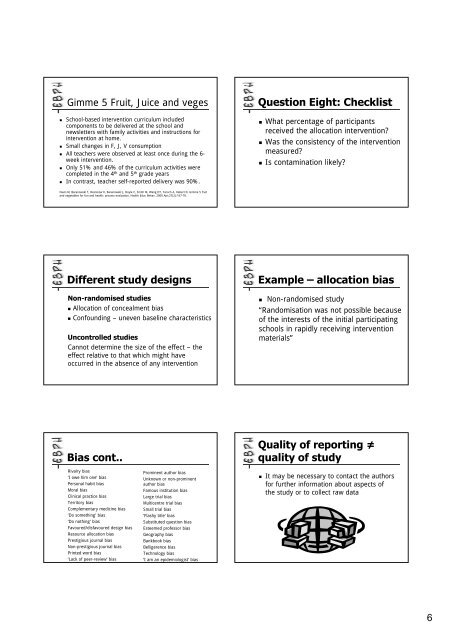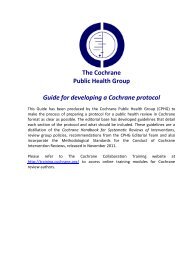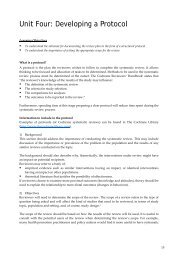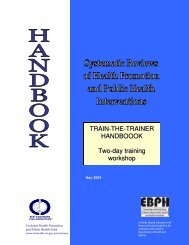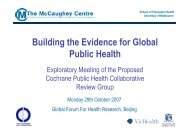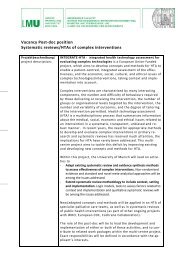Unit Eight: Principles of Critical Appraisal - Cochrane Public Health ...
Unit Eight: Principles of Critical Appraisal - Cochrane Public Health ...
Unit Eight: Principles of Critical Appraisal - Cochrane Public Health ...
Create successful ePaper yourself
Turn your PDF publications into a flip-book with our unique Google optimized e-Paper software.
Gimme 5 Fruit, Juice and veges<br />
• School-based intervention curriculum included<br />
components to be delivered at the school and<br />
newsletters with family activities and instructions for<br />
intervention at home.<br />
• Small changes in F, J, V consumption<br />
• All teachers were observed at least once during the 6-<br />
week intervention.<br />
• Only 51% and 46% <strong>of</strong> the curriculum activities were<br />
completed in the 4 th and 5 th grade years<br />
• In contrast, teacher self-reported delivery was 90%.<br />
Question <strong>Eight</strong>: Checklist<br />
• What percentage <strong>of</strong> participants<br />
received the allocation intervention?<br />
• Was the consistency <strong>of</strong> the intervention<br />
measured?<br />
• Is contamination likely?<br />
Davis M, Baranowski T, Resnicow K, Baranowski J, Doyle C, Smith M, Wang DT, Yaroch A, Hebert D. Gimme 5 fruit<br />
and vegetables for fun and health: process evaluation. <strong>Health</strong> Educ Behav. 2000 Apr;27(2):167-76.<br />
Different study designs<br />
Non-randomised studies<br />
• Allocation <strong>of</strong> concealment bias<br />
• Confounding – uneven baseline characteristics<br />
Uncontrolled studies<br />
Cannot determine the size <strong>of</strong> the effect – the<br />
effect relative to that which might have<br />
occurred in the absence <strong>of</strong> any intervention<br />
Example – allocation bias<br />
• Non-randomised study<br />
“Randomisation was not possible because<br />
<strong>of</strong> the interests <strong>of</strong> the initial participating<br />
schools in rapidly receiving intervention<br />
materials”<br />
Bias cont..<br />
Quality <strong>of</strong> reporting ≠<br />
quality <strong>of</strong> study<br />
Rivalry bias<br />
‘I owe him one’ bias<br />
Personal habit bias<br />
Moral bias<br />
Clinical practice bias<br />
Territory bias<br />
Complementary medicine bias<br />
‘Do something’ bias<br />
‘Do nothing’ bias<br />
Favoured/disfavoured design bias<br />
Resource allocation bias<br />
Prestigious journal bias<br />
Non-prestigious journal bias<br />
Printed word bias<br />
‘Lack <strong>of</strong> peer-review’ bias<br />
Prominent author bias<br />
Unknown or non-prominent<br />
author bias<br />
Famous institution bias<br />
Large trial bias<br />
Multicentre trial bias<br />
Small trial bias<br />
‘Flashy title’ bias<br />
Substituted question bias<br />
Esteemed pr<strong>of</strong>essor bias<br />
Geography bias<br />
Bankbook bias<br />
Belligerence bias<br />
Technology bias<br />
‘I am an epidemiologist’ bias<br />
• It may be necessary to contact the authors<br />
for further information about aspects <strong>of</strong><br />
the study or to collect raw data<br />
6


